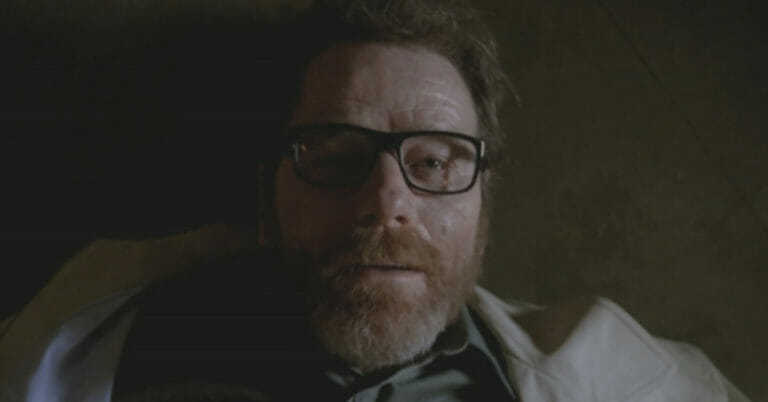Sign up for the
TSL Newsletter
and get $50 off Final Draft 12
By Danielle Karagannis · October 11, 2019

Breaking Bad, Written by Vince Gilligan, is one of the best shows, arguably the best show, in the history of television. Having a sweeping impact on the transition of this medium becoming more thoughtfully cinematic through story, character, and visuals.
This beloved show, which has the remarkable ability to toy with its audience’s psyche, as well as make you hate a character one second, then love them the next — even when it comes to the show’s villains, which some of them can be reasoned as heroes.
Download the pilot script for BREAKING BAD here for free.
Vince Gilligan, the show’s creator, also created Better Call Saul (a spin off that centers on Breaking Bad’s gaudy lawyer, Saul Goodman) which has major cross overs the later seasons. So for all you Breaking Bad geeks out there, like myself, I’m taking us back to its masterpiece of a series finale, “Felina”, and the impeccable use of set up that’s exhibited through the following…
It has been long understood that the show is a drama, fueled heavily through character, a rollercoaster of gut punching emotions, cliff hangers, and twists. What Gilligan does with the finale, something he’s mastered throughout the show’s entirety, is meticulous setup. “Felina” being no different, with an immediate painting stroked that depicts the episode’s tone.
It starts on a close up of a white substance — a drug of some sort? To reveal it’s actually snow overtaking a car window, as a hand wipes a small part off to reveal Walter White’s face. From there, he enters the car and it’s a long take of focusing on him, being with him. We simply watch Walt as he goes through what he’s going through, what he’s set out to do, where he needs to go… All without telling. Instead, enticing us. Through this, subtitles are revealed and the tone of the episode is clearly defined — dark, internal, and goal-oriented.
INT. OLD VOLVO SEDAN - NIGHT WALTER WHITE climbs behind the wheel, setting down a familiar PACKAGE on the seat beside him. We’ll recall this as the box of cash which we established in episode #515. Same box, SAME CLOTHES. The sun has set, but we’re picking up only an hour or two after #515 ended. We’re still in New Hampshire, in the same small village. Walt carefully shuts the driver’s door. This is because for the moment, he’d like to keep in place the thick blanket of SNOW which covers the windshield and every window. It will afford him much-needed privacy for what he has to do next. Please note that this Teaser will take place entirely within the confines of the Volvo. Except for the final shot, we will always be right here inside it with Walt. Whatever light there is comes from unseen streetlights filtering through the snow. When Walt opened the door just now, what little we saw outside was maybe the BRICK WALL of an alley or somesuch. That’s all. This is going to feel claustrophobic. It’s supposed to.
Note Gilligan’s emphasis in the above, communicated twice — the purposeful detail of wanting the audience to feel stuck in this car with Walt.
Having closed the door, Walt rubs his hands and blows on them, desperately trying to warm up. He’s shivering, teeth chattering -- he’s been out in the cold too long, evading the local police (as per last episode). He’s COUGHING now, too. Things aren’t looking good. He’s in bad shape. First order of business is to start this Volvo -- to get the heat fired up and get the hell outta here before he’s busted. No key in the ignition. Beggars can’t be choosers. Walt starts looking around and feeling around -- atop the dashboard, under the seats, in the backseat, in the passenger footwell. He yanks open the glove box and fumbles in it, coming out with... what’s this..? WALT’S POV -- AN OLD CASSETTE CASE Is balanced half-open and EMPTY in Walt’s fingers. It’s “Gunfighter Ballads and Trail Songs” by Marty Robbins. A classic. But it’s not gonna help. Walt tries again, fishing deeper. And now -- yes! A flat-head SCREWDRIVER. Excellent! Walt goes to work with it, prying at the steering column. Has Walt ever hot-wired a car in his life? No, but how hard could it be? Especially an old model like this. Once he breaks this column open and frees the ignition cylinder, it’s probably just a matter of touching together two little wires... two tiny little wires… Fuck! How do I get to those wires?! Try as he might, Walt can’t seem to crack this column open. What is this, Fort Knox? Who the hell designed this thing?! He might have better luck on a warm and sunny, not-dying-of- cancer day. But in his reduced state, so thin and cold and coughy that he can barely grasp the screwdriver, Walt senses defeat... and begins to panic.
Walt is a twisted cross of a protagonist and antagonist, the show’s leading man, and the epitome of purpose behind Breaking Bad. It’s no surprise that the finale begins with Walt (and ends with Walt).
Referring to the same opening segment as above — he hardly says anything, yet it’s all we need to know. At this rate, he’s so distinctly defined that the audience can understand him well enough — down to how he carries himself, his expressions, mannerisms, and so forth. Between such attentive characteristics, as well as his minimal dialogue to start, we know that we’ll be journey’ing alongside very specific intentions of his.
Now he flops back and just sits here, freezer smoke jetting out of his mouth like one of those Clydesdales on a Budweiser Christmas commercial. But he’s not giving up. WALT You want this. You wouldn’t have brought me this far if you didn’t. Wait... is this a prayer? If so, to whom is it addressed? Your call. Regardless, it doesn’t seem to pay dividends. Because now… BLUE LIGHTS can be seen FLASHING through the thick snow of the windshield. They’re growing BRIGHTER -- approaching us. An unseen POLICE CAR is headed our way. We can tell it’s cruising slowly, its headlights and rollers on but its siren off. And now it slows to a CRAWL... and finally STOPS a mere ten feet away. Walt sits motionless. Wide-eyed and rigid. This cop car (invisible to us save for its blue flashers) is so goddamned close that we can hear the squawk of its RADIO. Instinctively, Walt’s got that screwdriver gripped tight like a weapon. Otherwise, he doesn’t move a muscle. Do the cops know he’s here? We hear no car doors opening, no shouted commands. But now, making Walt’s sphincter pucker two stops tighter… ... A FLOODLIGHT kicks on, practically blinding us. It sweeps back and forth, very mechanically. It’s searching through the snow at us. Fishing. Walt is scared... somewhat. But mostly, he looks angry. Under his breath and barely audible, the floodlight sweeping hither and yon, he continues his prayer. WALT Get me home. I’ll do the rest.
As mentioned in “Introducing the main character(s)”, we’re hinted that a journey is ahead for Walt, which turns out to be true. What that ultimately entails is his version of finding closure, seeking justice, and making things “right.” As if Walt had a list of people he needed to address in order to accomplish this, before the inevitable were to occur: him dying of cancer… Or, something else getting to him first. Within the first ten pages, we are met with the initial people that starts this off: Gretchen and Elliot Schwartz, aka the life he could have and should have had.
Walt is Heisenberg, for better or worse, and in the finale, it appears he’s accepted this on a level we haven’t seen previously. In “Felina”, a darker essence embodies him — the audience can truly sense a man who has nothing to lose. Barely clinging onto life and having lost everything that actually matters — there’s an understanding that it’s all or nothing, this being imperative toward him seeing things through.
Walt is set out to accomplish something. We learn that it’s making rounds with specific individuals to ensure he provides for his family, financially and through protection, before he’s gone. Both of these being deeply personal to him, as this is why he claimed to cook meth in the first place. But as the show carried on, it became evident it was for internal selfish fulfillment. Meanwhile in “Felina”, it actually seems like he means it for once. Granted, having slaughtered the trust of those who hold importance, him wanting to do “right” feels small toward whom he has failed: Skylar, Walt Jr., Hank… And whether you loathe Walt or not, he still manages to earn a level of redemption.
How this begins in the episode:
Walt is finished pumping gas and stands here by the edge of the quiet
highway, the receiver to his ear. A beat, then:
WALT
Hi, this is David Linn from the New
York Times. May I speak to Susan? Thank you.
Cool Walt peruses a hangnail, then blandly stares off at the horizon.
The hell’s he up to?
WALT
Hi, Susan, it’s David again. I was
just calling to see if --
(listens)
No, I figured we’d do the interview by phone, seeing as they’re no
longer in the city. But we’d really love a photo of Mr. and Mrs. Schwartz
to go along with the article. We’ve got a stringer out of Albuquerque who
we like a lot. When are they scheduled to return home? Think maybe we could --
(listens)
So, they’re home tonight, then. Gotcha. Are they still at, uh... the address
I have is Upper Canyon Road. Is that? --
(listens)
Oh, Tesuque. Is that near the Opera House? I hear that’s very nice.
Pulling up his sleeve, Walt WRITES an ADDRESS on the inside of his forearm
(let’s find an address we can clear).
WALT
Okay, then. Lemme call my
photographer, check out his availability.
(listens)
No, no, their call. Any day this week, we’re at their disposal. I know the
Schwartzes are very busy people. Listen, thank you so much for your time.
You too. Bye-bye.
Whatever this is about, it does not sound like good news for Gretchen
and Elliott!
Walt hangs up, quietly satisfied. Off him, REFLECTED in the steel casing
of the payphone as he walks away from us, headed back to his car...
It’s incredibly captivating and special to take in Gillian’s writing style, a clear passion for his characters and their story — it jumps off the page.
 Danielle Karagannis is a writer/director. She currently has a feature script entitled INSOMNIA! (ensemble comedy) that’s been accepted into filmmaker labs and recently took her to the 2018 Berlinale / EFM. You can watch Danielle‘s latest film, GIRL (short), here and can follow her on Instagram.
Danielle Karagannis is a writer/director. She currently has a feature script entitled INSOMNIA! (ensemble comedy) that’s been accepted into filmmaker labs and recently took her to the 2018 Berlinale / EFM. You can watch Danielle‘s latest film, GIRL (short), here and can follow her on Instagram.
For all the latest from The Script Lab, be sure to follow us on Twitter, Facebook, and Instagram.